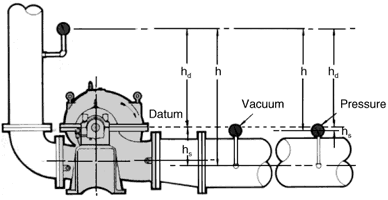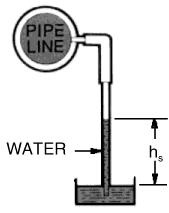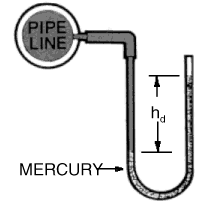The total head of a pump can be determined by gauge readings as illustrated in Fig. 1.

Fig 1 Determination of Total Head from Guage Readings
TDH = Discharge gauge reading converted to feet of liquid + vacuum gauge reading converted to feet of liquid + distance between point of attachment of vacuum gauge and the centerline of the discharge
or TDH=Discharge gauge reading converted to feet of liquid-pressure gauge reading in suction line converted to ft. of liquid + distance between center of discharge and suction gauges, h, in feet
The final term in the above definitions accounts for a difference in size between the suction and discharge lines. The discharge line is normally smaller than the suction line and thus the dis-charge velocity is higher. A higher velocity results in a lower pressure since the sum of the pressure head and velocity head in any flowing liquid remains constant. Thus, when the suction and discharge line sizes at the gauge attachment points are different, the resulting difference in velocity head must be in-cluded in the total head calculation.
Manometers can also be used to measure pressure. The liquid used in a manometer is normally water or mercury, but any liquid of known specific gravity can be used. Manometers are extremely accurate for determining low pressures or vacuums and no calibration is needed. They are also easily fabricated in the field to suit any particular application. Figs. 2 & 3 illustrate typical manometer set ups.
 Fig. 2 Manometer Indicating Vacuum
Fig. 2 Manometer Indicating Vacuum 
Fig. 3 Manometer Indicating Pressure


